Do you have a question about the HERO SPLENDOR NXG and is the answer not in the manual?
Details the VIN format and location on the motorcycle.
Details the Engine Number format and location on the motorcycle.
Provides the physical measurements of the motorcycle.
Specifies the kerb weight of the motorcycle.
Lists the fluid capacities like engine oil and fuel tank.
Details engine performance, bore, stroke, compression, and spark plug.
Outlines essential do's and don'ts for safe operation of the motorcycle.
Provides recommendations for fitting accessories to ensure safety and performance.
Advises against modifying the motorcycle's original design or operation.
Illustrates the location of various motorcycle parts with numerical labels.
Explains the function of the speedometer panel instruments and indicators.
Guides on checking the engine oil level using the dipstick.
Step-by-step instructions for adding engine oil to the motorcycle.
Lists recommended tyre sizes and correct air pressure for safe riding.
Check engine oil level and top up if required.
Ensure sufficient fuel is available for the journey.
Inspect front and rear brakes for proper operation and free play.
Verify tyre condition and ensure correct inflation pressure.
Ensure smooth clutch operation and adjust free play if needed.
Inspect drive chain condition, slackness, and lubrication.
Verify smooth throttle opening and closing.
Confirm proper function of all lights and the horn.
Adjust rear view mirrors for optimal visibility.
Ensure all fittings and fasteners are tight and secure.
Check for smooth steering action and maneuverability.
Verify secure connections of the air suction valve tubes.
How to apply brakes for normal stopping and downshifting.
Techniques for maximum deceleration and emergency stopping.
Proper procedures for parking the motorcycle safely.
Tips to prevent motorcycle theft and enhance security.
How to open, close, and use the motorcycle's utility box.
Lists the tools provided in the motorcycle's tool kit.
Details the items included in the motorcycle's first aid kit.
How to check and adjust throttle grip free play.
Explanation of valve clearance and its importance for engine performance.
Procedure for setting the engine's idle speed via the carburetor.
Steps to adjust clutch lever free play for smooth engagement.
Additional checks for clutch cable condition and routing.
How to inspect the drive chain for slack and wear.
Procedure for adjusting the drive chain slack and alignment.
Guidelines for lubricating the drive chain for optimal service life.
How to adjust the front brake lever free play.
How to adjust the rear brake pedal free play.
How to check front brake shoe wear using indicators.
How to check rear brake shoe wear using indicators.
Details the motorcycle's battery type and specifications.
Guidance on charging, storing, and handling the motorcycle battery.
Steps involved in safely removing the motorcycle battery.
Instructions for replacing blown fuses in the electrical system.
How to adjust the stop lamp switch for correct brake light operation.
How to inspect the front forks and rear shock absorbers for proper function.
How to adjust the rear shock absorbers for different load conditions.
Information about the catalytic converter and its protection.
Explanation of the air suction valve's role in emission control.
Troubleshooting steps for when the engine fails to start.
Troubleshooting for engine stalling after starting.
Diagnosing and fixing issues related to poor acceleration or pick-up.
Troubleshooting for feeble horn sound or no lights.
Troubleshooting for problems with the i3s (idle stop-start) system.
Explains mandatory traffic signs and their importance.
Explains cautionary traffic signs and their purpose.
Explains informatory traffic signs and their function.
Outlines the vehicle's warranty period and general terms.
Lists conditions and exclusions not covered by the warranty.
Defines the scope and validity period of the emission warranty.
Outlines the terms and conditions for availing the emission warranty.
Highlights the advantages of using genuine Hero spare parts.
Details damages from using non-genuine clutch plates.
Details damages from using non-genuine cam chain kits.
Details damages from using non-genuine cylinder head gaskets.
Details damages from using non-genuine air cleaner elements.
Details damages from using non-genuine spark plugs.
Details damages from using non-genuine brake pads or shoes.
Details damages from using non-genuine chain sprocket kits.
Contact information for Hero MotoCorp offices in the Central Zone.
Contact information for Hero MotoCorp offices in the East Zone.
Contact information for Hero MotoCorp offices in the North Zone.
Contact information for Hero MotoCorp offices in the South Zone.
Contact information for Hero MotoCorp offices in the West Zone.
Details the VIN format and location on the motorcycle.
Details the Engine Number format and location on the motorcycle.
Provides the physical measurements of the motorcycle.
Specifies the kerb weight of the motorcycle.
Lists the fluid capacities like engine oil and fuel tank.
Details engine performance, bore, stroke, compression, and spark plug.
Outlines essential do's and don'ts for safe operation of the motorcycle.
Provides recommendations for fitting accessories to ensure safety and performance.
Advises against modifying the motorcycle's original design or operation.
Illustrates the location of various motorcycle parts with numerical labels.
Explains the function of the speedometer panel instruments and indicators.
Guides on checking the engine oil level using the dipstick.
Step-by-step instructions for adding engine oil to the motorcycle.
Lists recommended tyre sizes and correct air pressure for safe riding.
Check engine oil level and top up if required.
Ensure sufficient fuel is available for the journey.
Inspect front and rear brakes for proper operation and free play.
Verify tyre condition and ensure correct inflation pressure.
Ensure smooth clutch operation and adjust free play if needed.
Inspect drive chain condition, slackness, and lubrication.
Verify smooth throttle opening and closing.
Confirm proper function of all lights and the horn.
Adjust rear view mirrors for optimal visibility.
Ensure all fittings and fasteners are tight and secure.
Check for smooth steering action and maneuverability.
Verify secure connections of the air suction valve tubes.
How to apply brakes for normal stopping and downshifting.
Techniques for maximum deceleration and emergency stopping.
Proper procedures for parking the motorcycle safely.
Tips to prevent motorcycle theft and enhance security.
How to open, close, and use the motorcycle's utility box.
Lists the tools provided in the motorcycle's tool kit.
Details the items included in the motorcycle's first aid kit.
How to check and adjust throttle grip free play.
Explanation of valve clearance and its importance for engine performance.
Procedure for setting the engine's idle speed via the carburetor.
Steps to adjust clutch lever free play for smooth engagement.
Additional checks for clutch cable condition and routing.
How to inspect the drive chain for slack and wear.
Procedure for adjusting the drive chain slack and alignment.
Guidelines for lubricating the drive chain for optimal service life.
How to adjust the front brake lever free play.
How to adjust the rear brake pedal free play.
How to check front brake shoe wear using indicators.
How to check rear brake shoe wear using indicators.
Details the motorcycle's battery type and specifications.
Guidance on charging, storing, and handling the motorcycle battery.
Steps involved in safely removing the motorcycle battery.
Instructions for replacing blown fuses in the electrical system.
How to adjust the stop lamp switch for correct brake light operation.
How to inspect the front forks and rear shock absorbers for proper function.
How to adjust the rear shock absorbers for different load conditions.
Information about the catalytic converter and its protection.
Explanation of the air suction valve's role in emission control.
Troubleshooting steps for when the engine fails to start.
Troubleshooting for engine stalling after starting.
Diagnosing and fixing issues related to poor acceleration or pick-up.
Troubleshooting for feeble horn sound or no lights.
Troubleshooting for problems with the i3s (idle stop-start) system.
Explains mandatory traffic signs and their importance.
Explains cautionary traffic signs and their purpose.
Explains informatory traffic signs and their function.
Outlines the vehicle's warranty period and general terms.
Lists conditions and exclusions not covered by the warranty.
Defines the scope and validity period of the emission warranty.
Outlines the terms and conditions for availing the emission warranty.
Highlights the advantages of using genuine Hero spare parts.
Details damages from using non-genuine clutch plates.
Details damages from using non-genuine cam chain kits.
Details damages from using non-genuine cylinder head gaskets.
Details damages from using non-genuine air cleaner elements.
Details damages from using non-genuine spark plugs.
Details damages from using non-genuine brake pads or shoes.
Details damages from using non-genuine chain sprocket kits.
Contact information for Hero MotoCorp offices in the Central Zone.
Contact information for Hero MotoCorp offices in the East Zone.
Contact information for Hero MotoCorp offices in the North Zone.
Contact information for Hero MotoCorp offices in the South Zone.
Contact information for Hero MotoCorp offices in the West Zone.
| Displacement | 97.2 cc |
|---|---|
| Fuel System | Carburetor |
| Wheelbase | 1235 mm |
| Max Torque | 8.05 Nm @ 5000 rpm |
| Transmission | 4-speed constant mesh |
| Front Brake | Drum |
| Rear Brake | Drum |
| Front Suspension | Telescopic hydraulic shock absorbers |
| Bore x Stroke | 50 x 49.5 mm |
| Ignition | CDI |
| Clutch | Multiplate Wet |
| Front Tyre | 2.75 x 18 - 42 P |
| Engine Type | Single Cylinder, 4 Stroke, Air Cooled |
| Starting Method | Kick and Electric Start |
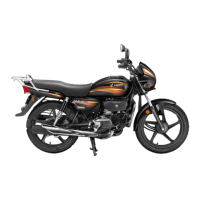
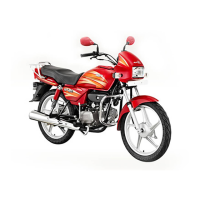
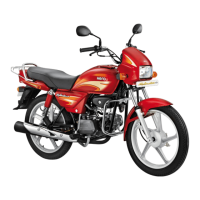
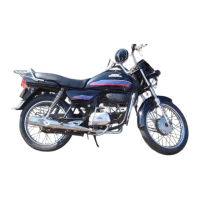
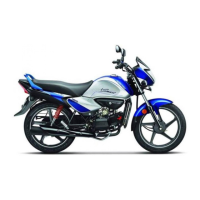
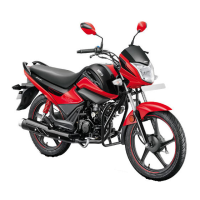
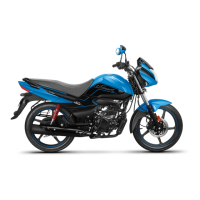
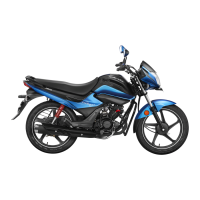
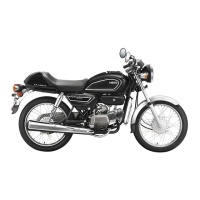

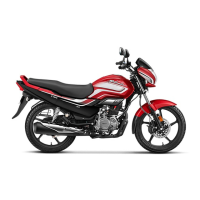
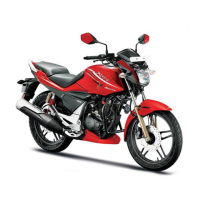
